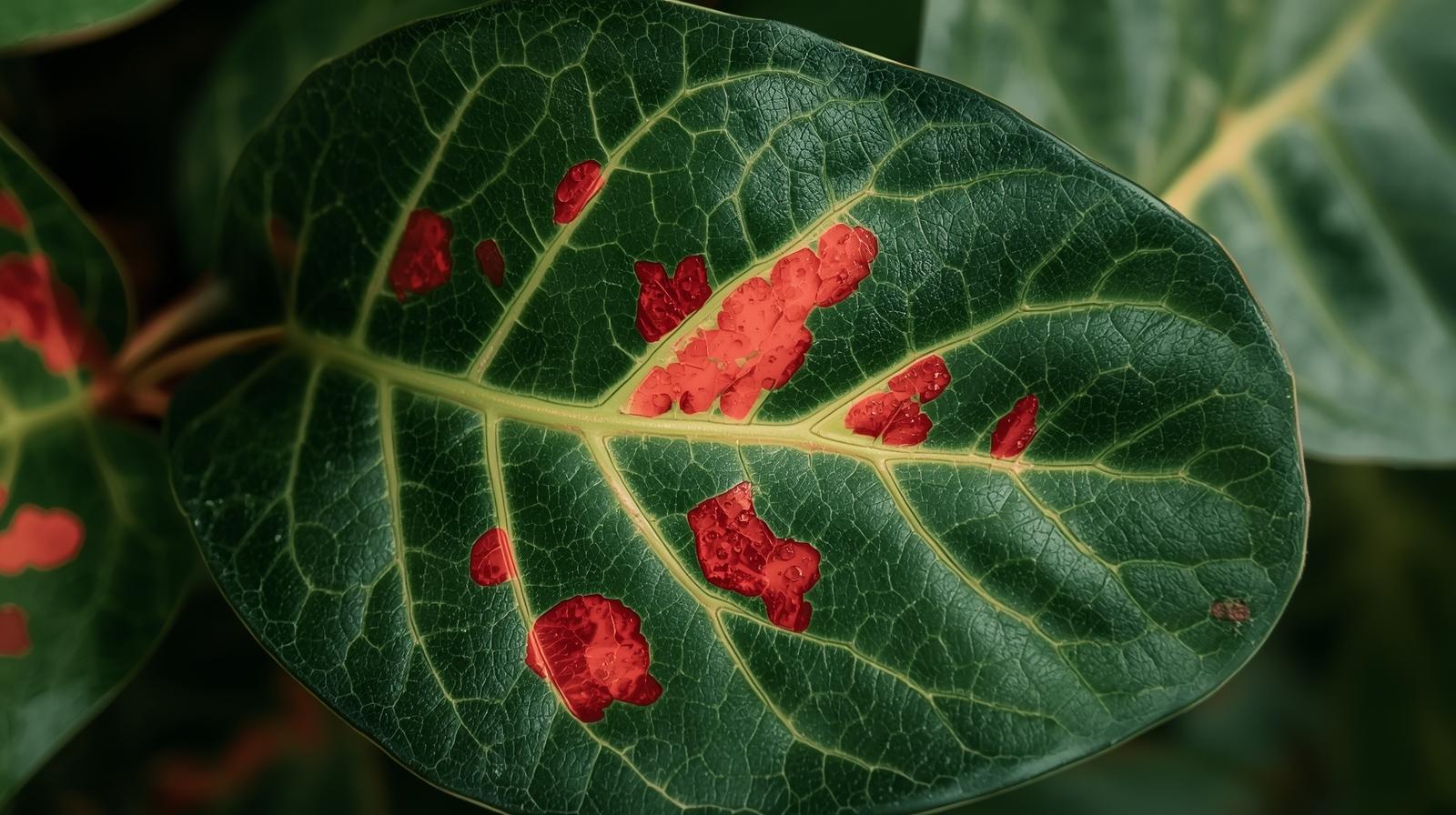Red spots appearing on your fiddle leaf fig leaves aren’t just cosmetic blemishes—they’re urgent distress signals that demand immediate attention to prevent permanent damage or plant loss.
After years of diagnosing fiddle leaf fig problems and helping plant parents navigate the anxiety of watching their beloved plants develop mysterious red markings, I’ve learned that these spots represent several distinct issues, each requiring specific treatment approaches.
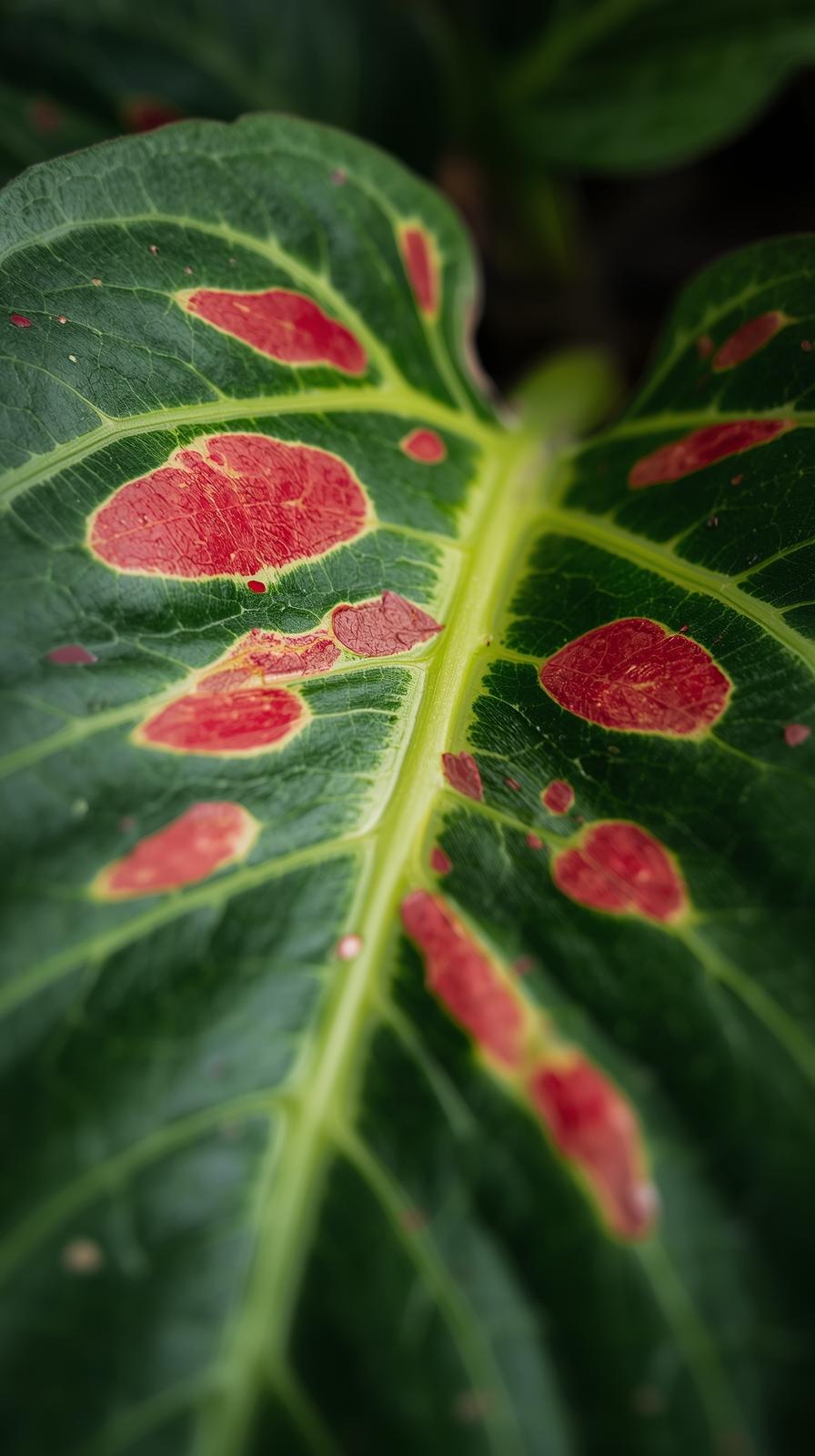
The frustrating reality is that red spots can indicate everything from minor environmental stress to serious fungal infections, making accurate diagnosis crucial for successful treatment. What makes red spots particularly concerning is their tendency to spread rapidly under certain conditions, transforming isolated blemishes into widespread leaf damage that compromises the entire plant’s health.
The key to saving your fiddle leaf fig lies in understanding what these red spots actually represent, identifying the underlying cause quickly, and implementing targeted solutions before the problem escalates beyond recovery.
Understanding Red Spot Causes and Diagnosis
Red spots on fiddle leaf fig leaves typically fall into three primary categories: bacterial infections, fungal issues, and environmental stress responses. Each category presents distinct characteristics that enable accurate diagnosis when examined systematically.
Bacterial leaf spot, caused by Xanthomonas species, creates small, reddish-brown spots with distinctive yellow halos surrounding the red centers. These spots often appear water-soaked initially, gradually developing the characteristic red coloration as the infection progresses. The spots typically measure 1-4mm in diameter and may eventually develop holes as infected tissue dies and falls away.
Fungal infections, particularly those caused by Phyllosticta species, produce red spots with more defined borders and darker centers. Unlike bacterial spots, fungal spots often display concentric rings or target-like patterns as the infection spreads outward from the initial infection site. These spots tend to be larger than bacterial spots and may develop gray or black centers over time.
Environmental stress-induced red spots result from cellular damage caused by temperature fluctuations, light exposure changes, or water stress. These spots typically appear more uniform in color without the distinct halos or patterns associated with pathogenic infections. They often coincide with other stress symptoms like leaf yellowing or browning edges.
Location patterns on leaves provide additional diagnostic clues. Bacterial infections often begin on lower leaves and spread upward, while fungal infections may appear randomly throughout the plant. Environmental stress spots typically affect the most exposed leaves or those closest to stress sources like heating vents or windows.
The progression timeline helps distinguish between causes. Bacterial and fungal spots spread relatively quickly, with new spots appearing within days of initial symptoms. Environmental stress spots develop more slowly and may stabilize once stress factors are addressed.
Seasonal timing offers another diagnostic indicator. Bacterial and fungal infections are more common during warm, humid conditions, while environmental stress spots often coincide with seasonal changes, heating system activation, or other environmental shifts.
Bacterial Leaf Spot: Identification and Treatment
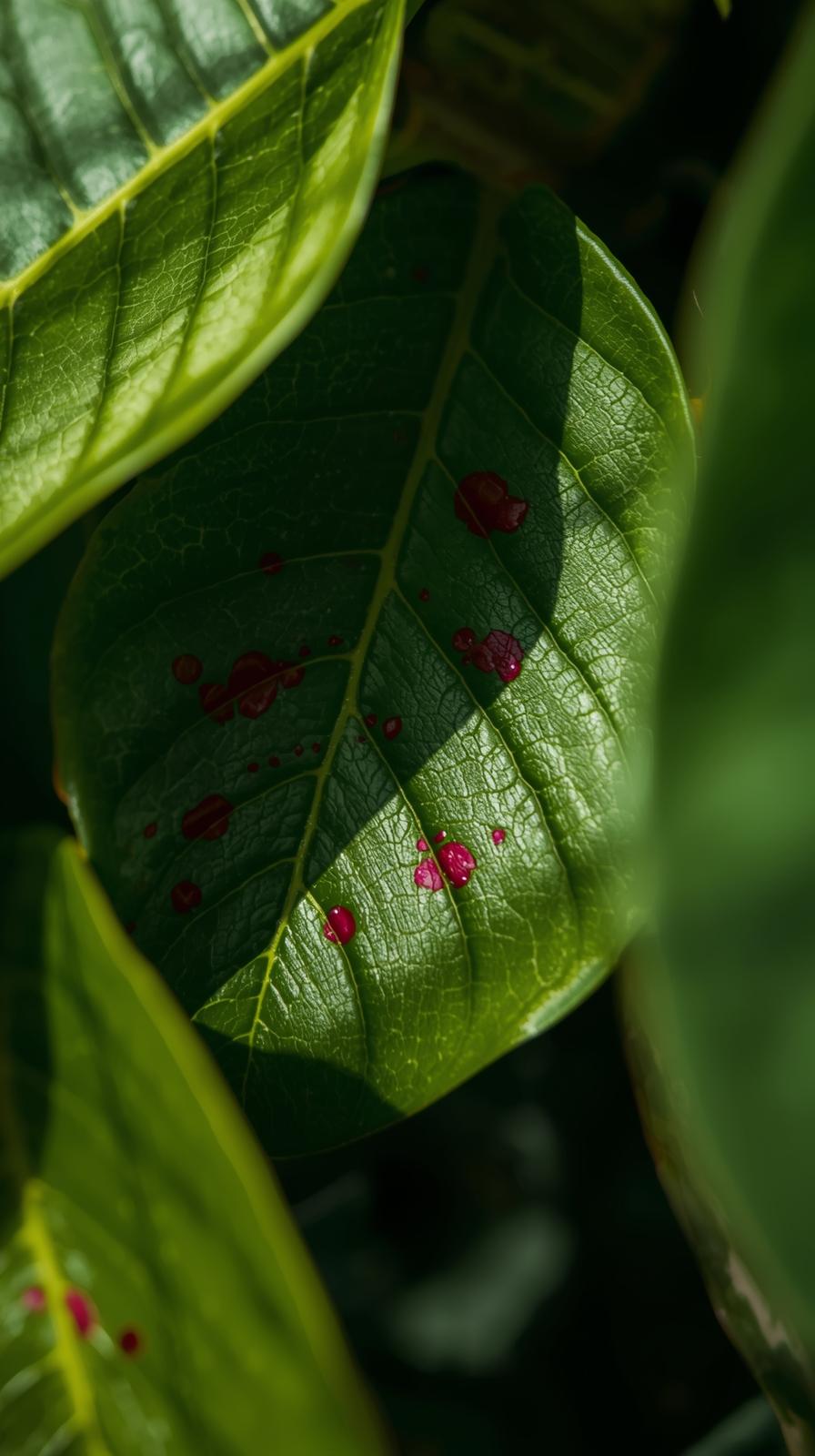
Bacterial leaf spot represents one of the most serious causes of red spots on fiddle leaf figs, requiring immediate intervention to prevent plant loss. The distinctive appearance includes small red or reddish-brown spots surrounded by bright yellow halos that create a bull’s-eye appearance easily distinguished from other spot types.
The water-soaked appearance of early bacterial spots provides an early warning sign that enables prompt treatment. These spots feel slightly soft or mushy when gently pressed, unlike the firm texture of healthy leaf tissue or the dry texture of environmental damage spots.
Bacterial spread occurs rapidly through water splash, contaminated tools, or direct plant contact. High humidity conditions and overhead watering accelerate bacterial transmission, making environmental management crucial for treatment success. The bacteria enter leaves through natural pores or minor wounds, establishing infections that spread internally through leaf tissue.
Treatment begins with immediate isolation of affected plants to prevent bacterial spread to healthy specimens. Remove all affected leaves using sterilized pruning shears, cutting at least one inch below visible symptoms to ensure complete removal of infected tissue. Sterilize tools between cuts using rubbing alcohol to prevent contamination spread.
Copper-based bactericides provide the most effective chemical treatment for bacterial leaf spot on fiddle leaf figs. Apply according to manufacturer directions, ensuring complete coverage of all leaf surfaces including undersides where bacteria often establish. Repeat applications every 7-10 days until no new symptoms appear for at least two weeks.
Environmental modifications support bacterial treatment by creating conditions unfavorable for bacterial growth. Reduce humidity around affected plants, improve air circulation, and eliminate overhead watering in favor of bottom watering or direct soil application. Maintain these conditions throughout treatment and for several weeks after symptoms disappear.
Prevention strategies focus on avoiding conditions that promote bacterial establishment. Water at soil level rather than on leaves, maintain adequate plant spacing for air circulation, and quarantine new plants before introducing them to established collections.
Fungal Infections: Recognition and Management
Fungal red spots on fiddle leaf figs display characteristic features that distinguish them from bacterial infections. These spots typically show more defined borders with darker centers that may develop gray or black coloration as spores mature. The concentric ring patterns or target-like appearance provide clear identification markers.
Fungal spore production becomes visible as spots mature, appearing as dark specks or fuzzy growth within spot centers. This spore production distinguishes active fungal infections from healed bacterial spots or environmental damage, indicating ongoing infection requiring treatment.
Environmental conditions favoring fungal development include moderate temperatures (70-80°F) combined with high humidity and poor air circulation. Unlike bacterial infections that spread primarily through water splash, fungal spores disperse through air currents, making airborne transmission a significant concern.
Treatment approaches for fungal infections differ from bacterial treatments in both timing and methods. Systemic fungicides containing propiconazole or myclobutanil provide more effective control than contact fungicides because they penetrate leaf tissue where fungi establish.
Application timing proves critical for fungal treatment success. Begin treatment at first symptom appearance, as established infections become increasingly difficult to control. Apply fungicides during cooler parts of the day to prevent leaf burn while ensuring thorough coverage of all plant surfaces.
Sanitation measures prevent fungal spread and reinfection. Remove fallen leaves immediately, as they provide spore sources for reinfection. Clean plant areas thoroughly, including surfaces where spores might accumulate. Improve air circulation around plants to create conditions unfavorable for fungal establishment.
Long-term management requires ongoing vigilance and environmental control. Monitor plants weekly for new symptoms, maintain appropriate humidity levels, and ensure adequate air circulation. Avoid overcrowding plants, which creates microclimates favorable for fungal development.
Environmental Stress Red Spots
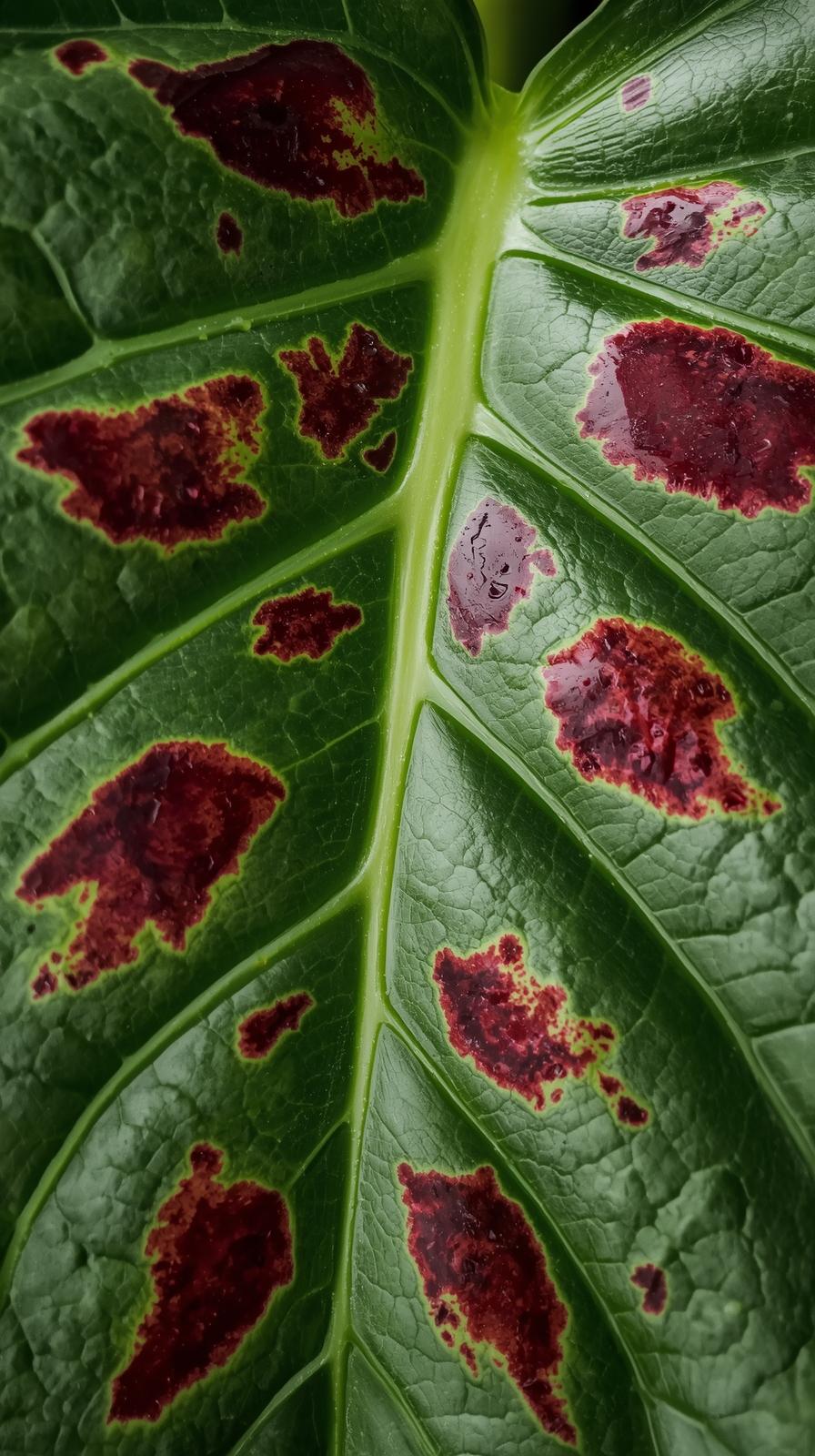
Environmental stress produces red spots through cellular damage mechanisms distinct from pathogenic infections. These spots result from disrupted cellular processes caused by temperature extremes, light changes, water stress, or chemical exposure rather than living organisms.
Temperature stress creates red spots through cellular membrane damage when plants experience rapid temperature changes or exposure to temperatures outside their tolerance range. Hot or cold drafts, proximity to heating/cooling vents, or sudden seasonal temperature shifts can trigger this response within 24-48 hours of exposure.
Light stress manifests as red spots when plants experience dramatic lighting changes, particularly increases in light intensity that overwhelm the plant’s adaptation capacity. Moving plants from low-light to bright locations without gradual acclimatization often triggers stress spots on newly exposed leaves.
Water stress, both under-watering and over-watering, creates cellular damage that appears as red spots. Drought stress damages cell membranes through dehydration, while waterlogged conditions create anaerobic root conditions that impair nutrient uptake and cellular function.
Chemical stress from over-fertilization, pesticide applications, or exposure to cleaning products can cause red spot formation. These chemicals disrupt cellular processes or create burn-like damage that manifests as red discoloration.
Treatment for environmental stress spots focuses on identifying and eliminating stress sources rather than applying chemical treatments. Stabilize temperature conditions, adjust lighting gradually, correct watering practices, and remove chemical exposure sources.
Recovery from environmental stress occurs slowly as plants generate new healthy growth to replace damaged tissue. Provide optimal growing conditions during recovery, avoiding additional stress that could compound existing damage.
Immediate Response Protocol
When red spots appear on fiddle leaf fig leaves, immediate action prevents minor issues from becoming plant-threatening problems. The first step involves careful examination to determine spot characteristics, distribution patterns, and progression rate.
Photography documentation helps track spot development and treatment progress. Take clear photos of affected areas from multiple angles, including close-ups showing spot details and wider shots showing distribution patterns. Date-stamp photos to monitor progression accurately.
Isolation procedures prevent potential pathogen spread while diagnosis and treatment proceed. Move affected plants away from healthy specimens, maintaining at least three feet separation. Avoid using the same tools or watering equipment between isolated and healthy plants without sterilization.
Initial treatment begins with removing severely affected leaves using sterilized pruning tools. Focus on leaves with extensive spotting or those showing signs of tissue breakdown. Make clean cuts at the leaf stem junction, avoiding tears that could provide pathogen entry points.
Environmental assessment identifies potential stress factors contributing to spot development. Check temperature consistency, humidity levels, watering practices, light exposure, and recent environmental changes that might trigger stress responses.
Treatment selection depends on diagnostic findings but should begin conservatively with environmental corrections before progressing to chemical treatments. Many red spot issues resolve with proper environmental management alone, avoiding unnecessary chemical applications.
Prevention and Long-Term Management
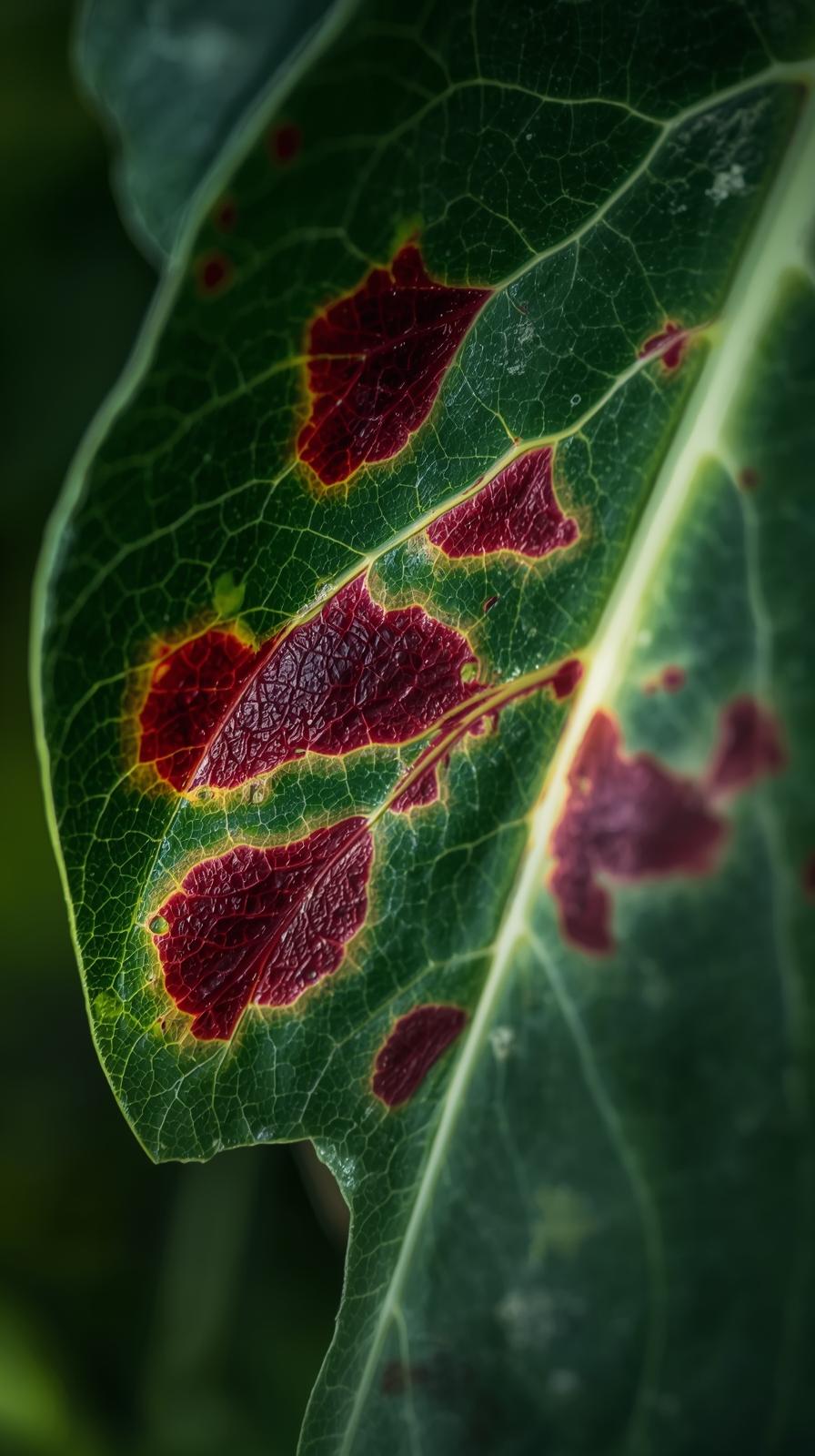
Preventing red spots on fiddle leaf figs requires comprehensive environmental management that addresses the multiple factors contributing to spot development. Consistent growing conditions prevent the stress that makes plants susceptible to both pathogenic and environmental damage.
Temperature stability proves crucial for red spot prevention. Maintain consistent temperatures within the 65-75°F range, avoiding locations near heating vents, air conditioning units, or drafty areas where temperature fluctuations stress plants.
Humidity management balances the need for adequate moisture without creating conditions favoring pathogenic development. Maintain 40-50% relative humidity through humidity trays, plant groupings, or room humidifiers while ensuring adequate air circulation prevents stagnant, humid conditions.
Watering practices significantly impact red spot development. Water at soil level rather than on leaves, allow soil to partially dry between waterings, and ensure proper drainage prevents waterlogged conditions. Consistent watering schedules prevent drought stress while avoiding overwatering issues.
Plant spacing and air circulation create environments unfavorable for pathogen establishment while supporting plant health. Maintain adequate spacing between plants, use gentle air circulation fans, and avoid overcrowded conditions that trap humid air around foliage.
Regular inspection enables early detection of red spot development when treatment is most effective. Check plants weekly, focusing on older leaves where symptoms often appear first, and examine both upper and lower leaf surfaces for early warning signs.
Tool sanitation prevents pathogen spread between plants during routine care activities. Clean pruning tools, watering equipment, and hands with rubbing alcohol when moving between plants, particularly when handling plants with suspicious symptoms.
Quarantine protocols for new plants prevent introduction of pathogens that could trigger red spot problems in established collections. Isolate new acquisitions for 2-3 weeks, monitoring carefully for symptom development before introducing them to established plant areas.
The successful management of red spots on fiddle leaf fig leaves requires understanding that these symptoms represent complex plant health issues demanding systematic diagnosis, targeted treatment, and comprehensive prevention strategies.
Whether dealing with bacterial infections, fungal problems, or environmental stress, the key to success lies in rapid response, accurate identification, and consistent follow-through with appropriate treatments.
By maintaining optimal growing conditions, implementing regular monitoring routines, and responding quickly to early warning signs, plant parents can prevent most red spot issues while successfully treating those that do occur, ensuring their fiddle leaf figs remain healthy, beautiful additions to their plant collections for years to come.

